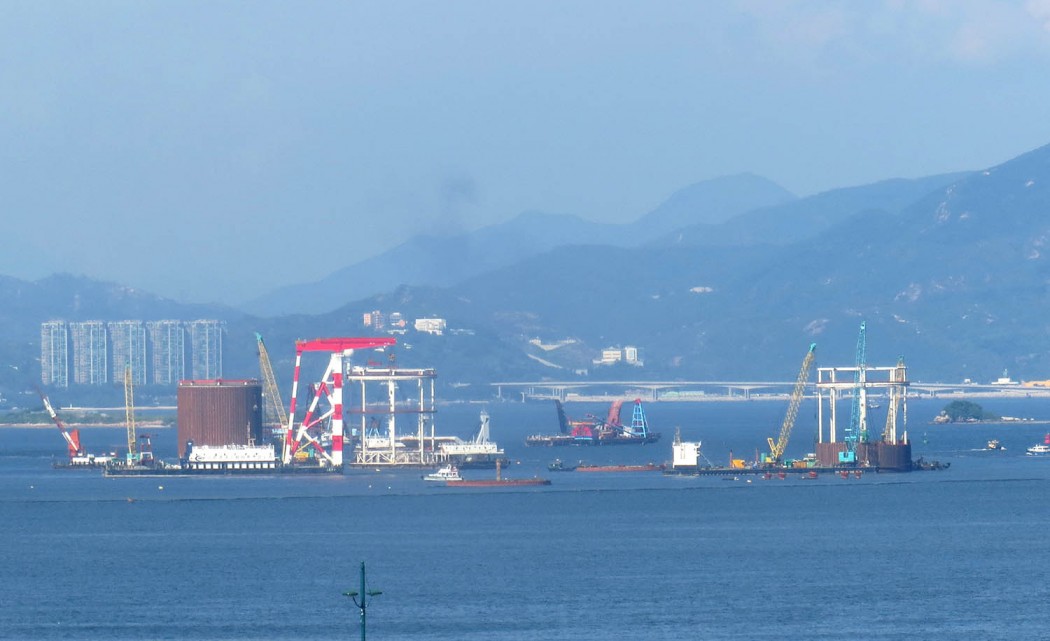The story about movement at the Hong Boundary Crossing Facilities (HKBCF) reclamation, which appeared on HowardWinnReports.com last week, attracted some attention.
The Highways Department subsequently issued two press statements in which it was at pains to stress that the movement that had occurred was anticipated and was ‘normal.’ Its view was obligingly echoed by certain English language media.
The story highlighted problems at the HK$7 billion HKBCF reclamation which is being built next to Hong Kong International Airport at Chek Lap Kok. The artificial island is a key element of the Hong Kong-Zhuhai-Macau bridge (HZMB) infrastructure.
For those readers who might be misled into thinking this is a fuss about nothing, here is a paragraph from the original story:
“The problem is that once again Hong Kong has allowed itself to be bullied into building this too quickly”, said one experienced engineering consultant. In the past Hong Kong has left reclaimed land to settle for between 5-15 years before building on it. “The problem with the HKBCF is that it hasn’t been left long enough and it is still settling.” Engineers are still considering what to do about the problem.”
Despite assertions from the Highways Department to the contrary, engineers say the movement has been bigger than anticipated.

The main problem is that the artificial island is taking longer to settle than anticipated, which is impacting on the other related projects. This includes the facilities on the island itself in addition to the Northern and Southern landing points for the Tuen Mun Link Road, the connection point on the island for the Hong Kong Link Road and other roads and bridges connecting the island to Hong Kong International Airport.
The project adopted a non-dredged method to form the artificial island, the first time this has been used in Hong Kong. The government said it was using this method as it was more environmentally friendly, though various reports say that the city is running out of sites for dumping mud.
Reclamation projects in Hong Kong have developed from being partially dredged to fully dredged, according to a 2010 report jointly written by engineers from the Highways Department and Ove Arup & Partners Hong Kong, entitled “Towards A Sustainable Reclamation for Hong Kong.”
In the case of fully dredged reclamations, the marine mud is dredged, carried away and dumped, and the dredged area is filled with either marine or river sand. The partially dredged approach involves dredging the sea wall area while the reclaimed area is undredged. So-called ‘ground improvement’ techniques such as mixing cement into the marine mud are sometimes used.

Another technique is to insert vertical drains into the reclamation to accelerate the process, by providing pathways to allow the water trapped in the mud to escape. To speed up the process a surcharge can be applied to the surface of the reclamation in the form of sand or rubble. This bears down on the marine mud and the idea is that this additional weight accelerates the process of squeezing out the water, thus reducing the time it takes to achieve ‘final settlement’ and enabling the reclamation to be used sooner.
A number of ‘Wick’ drains, designed to draw water out by wicking it to the surface, were used on the HKBCF reclamation and at the same time a surcharge has been applied in the form of sand and building waste. Consultants say that too much weight has been applied too quickly to the reclamation in order to try to meet the project’s tight timetable.
The effect of the surcharge on the marine clay has been to turn it from clay, as we know it, into so-called ‘remoulded clay’, which has very little strength and resistance to shearing. It becomes a kind of soup or toothpaste. As a result, it has been seeping into the sea and applying pressure to the caissons that make up the sea wall, sometimes leading to lateral movement or causing them to go out of shape.
At the same time the Wick drains that have been used in the hope of draining water from the clay have failed. The rate of settlement has been too fast, as a result of the excessive surcharge, and this has had a concertina effect on the drains and thus blocked the pathways for escaping water.

The government says it has adopted ground strengthening measures to try and stabilise the marine mud. But engineers say these have not been successful and believe that further expensive ground improvement techniques will have to be employed to increase the stability of the artificial island. Consultants say that contractors have been reluctant to build on the site, resulting in delays to their projects. Little is happening on the site at the moment while engineers consider what to do next.
The government has said that the movement at the island is ‘normal’ but this seems somewhat disingenuous and an attempt to play down the technical difficulties. This website understands that loss adjusters have been appointed, which suggests matters are not as ‘normal’ as the government would have us believe. In the fullness of time we may learn what claims have been made and how they have been settled and the reasoning behind the settlements. Then we will have a better understanding of what is or is not ‘normal.’
